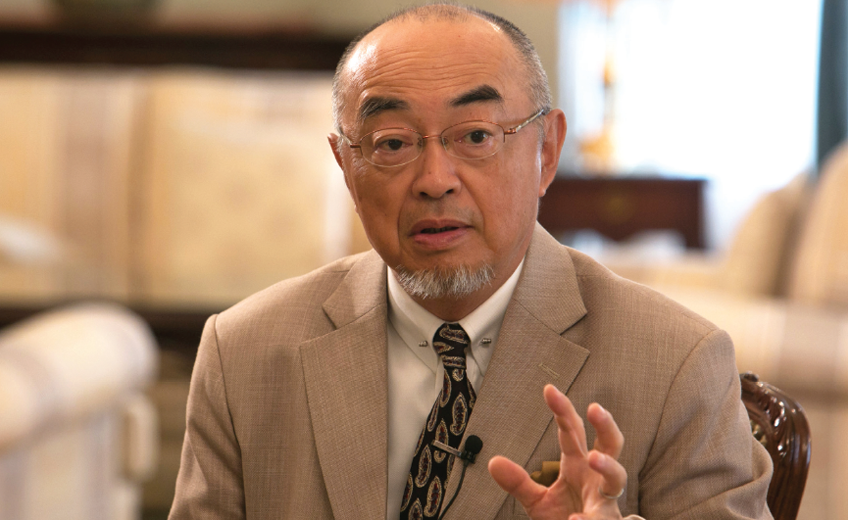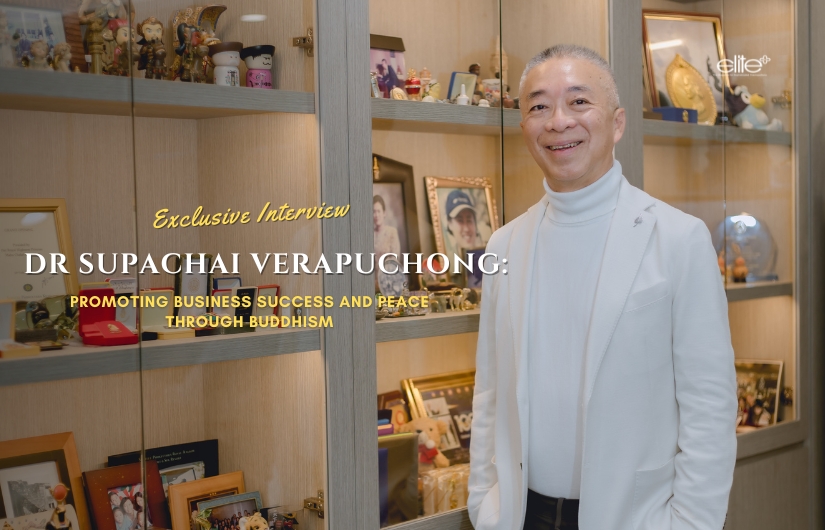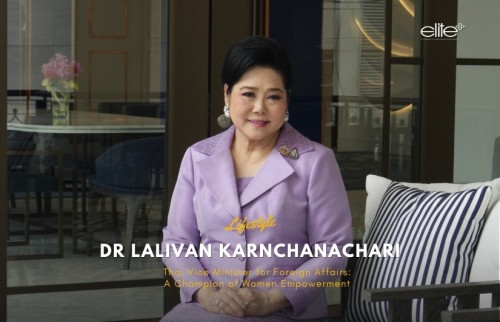Japan is among Thailand’s oldest allies. This friendship, now in its 130th year of diplomatic relations, has survived both hard and prosperous times as the two nations joined hands to overcome struggles and enjoy successes on numerous occasions. With more collaborations and co-development plans in the pipeline, Japanese Ambassador to Thailand Shiro Sadoshima reflects on the past and looks ahead to a bright future of bilateral relations, in an exclusive interview with Elite+ at his residence on Sukhumvit Road.
- What has contributed to the strong and cordial Japan-Thai relationship over the past 130 years?
Our history of exchanges goes back beyond 130 years, actually. An influential Japanese, Yamada Nagamasa, served the court during the Ayutthaya Era [400 years ago] as the chief martial, or some would say a mercenary, and he had several hundred samurais under his command. Yamada was also a merchant. He promoted trade between Siam and Japan. If you look at Thai history, you see that the Thai court was very flexible in terms of international trade. This flexibility welcomed some Japanese to the Kingdom to venture in their businesses, and since then our extensive exchange has continued.
Another reason, more recent, is economic investment. Japan is still one of the largest investors in Thailand, making up more than a third of direct foreign investment. Many more Japanese companies are planning to expand their businesses to Thailand. In the past few decades, Japanese companies have come to Thailand to operate with their counterparts in Thai companies, working together very successfully.
Our collaboration in terms of trade so far has become very fruitful. Take the Laem Chabang Eastern Seaboard, for instance. When the Thai government was thinking of developing an industrial zone in that area, the World Bank didn’t like the idea very much, saying the prospect for development was not very promising. On the other hand, Japan thought Thailand was an important place to have a foothold in investment in the region. Japan, having been a developing country itself, knew from its own experience that the plan could work, so we supported the Thai government. There were discussions about the pros and cons of the project in the country, of course, but eventually the Thai government gave it the green light.
This development soon helped Thailand build up its capacities to export automobiles. Twenty years ago the automobile was not one of Thailand’s exports. Now Thailand is a prime industrial base, producing and assembling automobiles both for its own use and for export. Japan and Thailand worked very hard to achieve this. We also muddled through a number of challenges together, including the Tom Yum Kung crisis in 1997. These common economic experiences have brought the two countries closer.
_485729910.png)
- Japan's and Thailand's royal families are also very close
That is one major factor that contributes to strong ties. There have been frequent visits between the two royal families, especially during the mid-19th century. These close exchanges between the countries’ heads of state’s family members helped strengthen our bond and promote mutual understanding. Last weekend at the Tokyo Marathon, Her Royal Highness Princess Bajrakitiyabha went to participate. Their Imperial Highnesses Prince and Princess Akishino were also here for the Royal Cremation Ceremony of His Majesty the late King Bhumibol Adulyadej.
- In terms of trade, what Thai products are popular in Japan?
Melamine foodware and plates in sushi bars all over Japan are mostly from Thailand. We also import a lot of natural cosmetics from Thailand, because our ladies love Thai products. Thai fruits and agricultural products are also well received in Japan. Some automobile products are imported back to Japan, and pickup trucks in Japan are largely manufactured here in Thailand.
- Japan, like many societies in the world, is ageing. How does the country address this?
In the last congress session, Prime Minister Abe addressed that Japan is now facing two national crises. One is the nuclear tests by North Korea, which pose a serious threat to us. Another, equally threatening, is the ageing population. We have a sharp decline in population and, at the same time, the average longevity of Japanese is around 84 years. We have introduced universal coverage of elderly insurance to provide daycare service support for ageing families in order to mitigate the difficulties. There are various kinds of subsidies for enterprises that introduce daycare services for the elderly.
As for the private sector, some companies intentionally hire elderly people. One famous business is the 'leaves business'. A company in Tokushima came upon the idea to sell decorative leaves and flowers and, to make the cost as low as possible; they hire retired people to collect seasonal plants and flowers from nature for the company to sell. This business has become a big hit. Even this embassy orders some leaves and flowers from them. Retired folks have become lively because they can work again, and fewer people go to nursing homes because they want to continue working.
- Ageing is also a threat to Thailand. Can you see the two countries working together to tackle this?
Thailand is experiencing a similar phenomenon, and our birth rates are alike. Japan’s is 1.4 and Thailand’s is 1.5. To maintain the level of population, the birth rate should be over 2.2, but you can see that both countries’ birth rates are below that level. It shows that Thai society is also moving forward to an aged society. The question of how to take care of this challenge is a common one for Japan. We work together with and extend support to Thai society in order to fight against the challenge. JICA has implemented the LTOP (the Project of Long-term Care Service Development for the Frail, Elderly and Other Vulnerable People), which is a special project for supporting Thailand to develop care services for elderly and vulnerable people.
In addition to support from the government sector of Japan, there are sizeable numbers of Japanese daycare companies coming to Thailand to explore business opportunities. Both the government sector and private sector of Japan are ready to tell of Japanese experiences and know-how, in order to help Thai society muddle through the crisis.
_1067184321.png)
- Cultural exchanges between Thailand and Japan are also prominent. What Thai cultural elements are popular in Japan?
Thai food is very popular now, and Thai restaurants are all over Japan. The number of Japanese restaurants in Thailand has also increased; the total now is 2,774 in the country, with 1,739 in Bangkok. Supermarkets in Japan also carry Thai food and seasoning. I can say that we very much like each other’s food!
- What about popular culture?
Animation is now very popular in Thailand. Last year the feature animation film Your Name was well received. There are often Japan-related festivals and fairs at shopping malls, and I see that they are very popular. I like cosplay and the animation culture. I find them interesting, and I’m delighted that a lot of Thais like them.
- Manga culture has seen a lot of changes during the past few decades. What is your view on it?
Manga in modern society is well accepted by both the young and old. When I was a kid, my parents would tell me not to waste time reading manga, and that I should work hard and study more. But young kids these days learn things from manga. Like Doraemon, readers can learn about history, languages, and even arithmetic from it. In a way, manga can provide more than textbooks. Manga is a very popular medium, so when Japan’s history is presented in manga style, people like it. Knowledge can be shared by a large number of people through manga. Several sub-cultures emerged from manga, like cosplay as I mentioned, and mascot characters that can be seen everywhere in Japan. Almost all the local authorities have at least one mascot. A lot of Thai people are passionate about these cultures too, and we would like to promote them further.
- Does the embassy have a mascot?
Oh, yes. He is called Muay Thaishi, a red snapper boxer. He’s supposed to come out of the Chaophraya river and, once he made it to land he heard about a country called Japan, and he wanted to visit. But to get there, he needed money to travel, so he came to our embassy to work part-time and save up for his trip to Japan. He has just finished a tour, where he visited and performed at more than 10 primary schools in the countryside.
- Japan has long been a prime tourism destination for Thais, especially after the relaxation of visa requirements. How do you see the situation?
Last year, almost a million Thai tourists went to Japan, and 62% of them are repeat visitors. It was a record high. Japanese travellers to Thailand also made a record: 1.54 million Japanese people came to Thailand last year. Thai tourists are one of the most welcomed groups in Japan, and the average Thai tourist spends about 40,000 baht during a visit to Japan. I think that, from Hokkaido in the north, all the way to Okinawa in the south, there has not been a town that Thai people have not been to. Some tourist spots were even popularized by Thai tourists. The other day a governor from a prefecture told me that a temple in the town was made a tourist spot by Thai travellers. Before that, the governor himself didn’t even know about the temple!
For 2018, the number of Thai tourists just for the first month of the year was already about 30% more than last year. We believe that by the end of the year the total number will be a new record.
- What do Japanese tourists like most about Thailand?
They love the food and the beautiful islands along the coastlines. Chiang Mai and Chiang Rai in the north are also popular destinations among Japanese. Some gentlemen love to come to play golf. My old friends from Japan sometimes come to visit in a large group, and we often play golf together. Golfing is one attraction in Thailand that Japanese people like. Another popular activity is scuba diving and snorkelling. Japanese ladies are fascinated by spa experiences in Thailand.
- What do you like to do in Thailand?
I would like to revisit some of those islands along the coastline. Another thing I would like to do is go sailing with my friend. Last time he was in Thailand we went to Phuket to look for a yacht to rent, but unfortunately he didn’t have much time, so we didn’t get to sail. I’m still waiting for that opportunity to sail on his next visit to Thailand.
In my free time, I paint. I go to markets in Bangkok and paint the market scenes. I take some photos from the market, come back home and paint. My goal is to paint 20 market scenes, and right now I’m halfway there. I’ve been to Khlong Toei market. It’s huge, and I don’t think I’ve been to any market this big elsewhere. It was a fun for me, and it’s very interesting.
- After almost three years in Thailand for you, what are the biggest similarities or differences?
If you look deeper, you’ll see that both Thailand and Japan have a rice production culture. And based on this, we have many things and features in common. For example, we both like group activities such as company outings and karaoke, the same way the whole village comes together to tend to rice production. Neither of us likes confrontational situations, and we tend to try to accommodate and compromise. We don’t honk so much when we drive, and we’re both pretty quiet people. The one distinctive difference is probably the Japanese way of meticulous planning, which we are very strict about, whereas Thai people would go sabai sabai. One Thai friend gave me a good explanation for this: he pointed out that, in Japan, you can harvest rice only once a year. So if you imagine we miss that one harvest, we would have to wait for another year to start again, and starve ourselves during that time. Here you can harvest three times a year. Even if you miss one harvest, you don’t stress as much, because in a few months you can have another go. And Thai people would have bananas, coconuts and so forth to survive on without rice, because food is plentiful here. It makes a lot of sense to me.
I would say we’re slightly different, but Japanese and Thai people come from the same roots. In my opinion, if we could have half the Thai traits and half the Japanese in one, that would make the perfect people.




























































































































































































































































































































































































































































































































































































































































































































































































































































































































